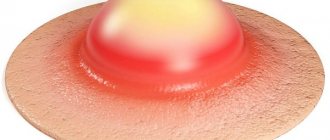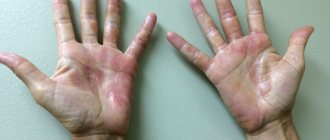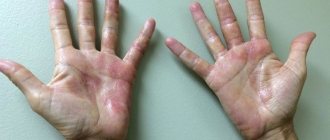The harmless formation of atheroma in the groin can greatly complicate urination and sexual intercourse. A round-shaped seal with clear boundaries, without pain during palpation, can reach a diameter of 3 cm, affecting surrounding tissues and organs. Appears from blockage of the sebaceous gland due to poor personal hygiene, infection or injury to the skin. The male sex is more predisposed to this disease, although cystic formations often appear in women. The growth of the formation is asymptomatic, but can cause inflammatory processes in the body. You cannot ignore a tumor; if it occurs, you must immediately undergo a diagnosis from a doctor.
Atheroma in the groin, as in other parts of the body, occurs due to blockage of the sebaceous glands.
What kind of disease
Atheroma is a benign formation, often with a genetic predisposition. An epidermal cyst looks like a thickening of the skin.
It consists of sebum and dead cells. Inside there is a white-yellow liquid with an unpleasant odor.
It is formed due to blockage of the sebaceous duct, then the discharge from it begins to accumulate under the skin and mixes with keratin. Atheroma can grow to large sizes if no measures are taken to eliminate it.
On this topic
- Female reproductive system
Differences between cytology and colposcopy
- Natalya Gennadievna Butsyk
- December 6, 2020
The tumor can be large or small, grow quickly or not change in size. Sometimes it can open on its own, then the liquid contained in it will flow out.
In such cases, it is important to prevent infection from entering the middle of the capsule, which can lead to infection. That's why it's so important to see a doctor.
Clinical picture
Atheroma grows in the subcutaneous tissue and is not connected to adjacent tissues. As a result of constant mechanical damage, it is injured, and a liquid with an unpleasant odor is released from the hole. It may be yellowish or white.
In some cases, the tumor capsule itself is released along with the secretion. If there are no particles left in the cavity, complete recovery occurs. But this happens in rare cases.
During the accumulation of secretions, the tumor does not appear, there is no discomfort or pain. Due to the fact that it grows slowly, a woman may not notice it for a long time. As a result of inflammation, which can develop for various reasons, the following symptoms occur:
- Increased temperature .
- Swelling of the soft tissue around the tumor.
- Aching or sharp pain when palpated.
If symptoms occur, you should contact a specialist, as there is a possibility that the tumor will degenerate into a malignant tumor.
Causes
The following factors can lead to the occurrence of atheroma:
- heredity;
- general hypertrophy;
- hormonal imbalance , which can cause hypersecretion of lipid substances in the glandular tissue of the skin;
- increased sweating;
- unhealthy diet, where fatty foods and sweets predominate;
- failure to comply with basic hygiene rules;
- metabolic disorders ;
- mechanical damage to the skin.
The development of atheroma largely depends on hormonal disorders in the body. When hormones are imbalanced, the oiliness of the skin increases, which significantly increases the likelihood of skin cysts.
The cause of the appearance of cysts in intimate places in women is often metabolic disorders, in particular the presence of a disease such as diabetes.
Why do inguinal atheromas form in women and men?
Atheroma in the groin most often looks like several small cysts covering the groin area. It starts with blockage of the sebaceous ducts. Despite the inflammation, the sebaceous gland continues to work and secrete sebum onto the surface of the skin. A dense capsule containing sebum and dead epithelial cells gradually forms. It is located in the lowest layer of skin - the dermis, and hurts when pressed. In the center there is a characteristic black dot - this is the exit of the sebaceous gland duct. Based on this feature, atheroma in the groin is distinguished from other subcutaneous neoplasms. This tumor occurs twice as often in men than in women.
The groin area is constantly subject to friction and compression, whether from uncomfortable underwear or tight clothing. If we add here a polluted environment and poor body hygiene, we get the main set of reasons for the occurrence of atheroma in the groin:
- Unsuccessful shaving and epilation, ingrown hairs.
- Groin damage, irritation from clothing.
- Poor hygiene of intimate areas.
- Hormonal imbalances.
- Profuse sweating.
- Allergic reactions, including to medications.
- Genetic predisposition.
- Hypothermia or overheating.
Although these cysts are not true tumors, when inflamed they pose a serious threat to your health.
The pubis is the second most common place for cystic rashes after the head. The peculiarity of the formation of atheroma in this zone is as follows: in addition to the abundance of hair follicles, many external secretion glands are concentrated in the groin - sebaceous, sweat. The secretion they produce creates good conditions for the proliferation of pathogenic bacteria, which, when they enter the excretory ducts of the hair follicles, cause inflammation.
The older the atheroma in the groin, the larger it is, it can reach 5-7 cm in diameter, therefore, it will be more difficult to remove it.
Atheroma on the pubis looks like a small, clearly defined dense lump. It does not hurt until inflammation begins in it. And this happens quite often and is caused by poor body hygiene, irritation of the groin from wearing low-quality clothes and underwear.
Symptoms
In appearance, atheroma is a small round formation. The cyst is smooth and mobile, has a dense consistency and clear boundaries.
There is no pain when pressing on the tumor, and there is no swelling or redness either.
In the center of the atheroma, the excretory duct of the sebaceous gland is often visible, which is increased in size.
If a tumor appears on the labia with similar symptoms, you should immediately contact a gynecologist.
Lipoma
This is a benign formation consisting of adipose tissue. In essence, it is a local accumulation of adipose tissue under the skin. Lipoma is a benign tumor, although in rare cases liposarcoma, a malignant formation, can develop under its mask.
Lipomas manifest themselves in the form of soft-elastic subcutaneous formations, mobile, painless, and can slowly increase in size. The skin over lipomas is not changed and easily moves over them. Small lipomas are not visible at all; they can only be detected by palpation. Larger lipomas stand out as “bumps” of round or oval shape. The size of lipomas is very variable - from 1-2 cm to 20 cm or more. Lipomas never become inflamed or suppurate.
Diagnostics
During examination and palpation, the doctor can easily diagnose atheroma. In the center of the formation, the outlet of the sebaceous duct is often visible, and if it is not completely closed, a yellowish liquid with an unpleasant odor will slowly ooze through it.
Through the thin skin of the labia, the doctor will be able to see the yellowish contents of the neoplasm. A dense structure also indicates atheroma.
The inflammatory process can make it difficult to make an accurate diagnosis. It occurs if a woman has ignored the appearance of atheroma for a long period, and the disease progresses.
In addition, diagnostics may include additional methods so that the doctor can make sure that the neoplasm is not malignant.
Prevention of neoplasms
Atheroma in the groin area can appear at any age in both men and women. Some precautions will help you reduce the risk of its occurrence and reduce the incidence of relapse:
- carefully observe intimate hygiene, use high-quality products;
- choose the right underwear according to size and fabric composition;
- practice protected sex;
- do hair removal only from highly qualified professionals;
- razors must be of high quality and kept clean;
- Eat a balanced diet to strengthen your immune system.
In general, atheroma in the groin area is not a health hazard. You just need to be attentive to your body and health, and if necessary, do not put off visiting a doctor for too long.
Treatment methods
The most effective method of treating atheroma today is to remove it surgically. Surgery to remove the tumor is performed in almost all cases when it is diagnosed.
Several types of surgery are possible.
Opening and husking the contents
This is a classic surgical method, during which the doctor makes an incision and removes the atheroma capsule along with the fluid it contains, after which self-absorbing sutures are applied. The disadvantage of this method is the possibility of relapse due to incomplete removal of the cyst contents.
Removal of atheroma and surrounding tissues
The method is used for severe inflammation. This type of operation has a significant drawback: scarring.
Endoscopic method
The operation is performed by inserting an endoscope into a small puncture and sucking out the contents of the atheroma capsule. It is quite difficult to accurately determine whether all the fluid has been removed from the capsule, so the possibility of relapse remains. The advantage of the method is the absence of seams.
Laser removal
This type of atheroma removal can be used when it is small in size. The method has a minimal risk of complications and a short recovery period.
There is another method that can be used to resolve atheromas. It involves the introduction of special drugs and carries certain risks.
The danger of using this method is that there is a high probability of relapse due to the inability to determine whether the tumor has completely reabsorbed or not.
On this topic
- Female reproductive system
Echosigns of adenomyosis
- Olga Vladimirovna Khazova
- December 4, 2020
Also, drugs can have a reverse effect on atheroma, accelerating its growth. If the treatment is effective, the result will be noticeable only after two months.
Only the doctor should choose which method will be used to eliminate the problem. The decision is made individually in each case, after the doctor evaluates all the risks and chooses the least traumatic method.
Today, it is also practiced to treat cysts in the vaginal area in women without surgery, but only if they are small in size.
3.Bartholinitis
Bartholinitis
- This is a consequence of blockage of the Bartholin gland. It is located at the entrance to the vagina and is involved in lubrication (moistening) of the external genitalia. During moments of sexual arousal, this process is especially intense. When a blockage of the gland duct occurs, a cyst is formed in which the produced secretion accumulates. If therapeutic measures are not taken, infection and cyst rupture often occur. This gives relief because the cavity is freed from accumulated secretory masses. However, the consequences of such spontaneous opening against the background of an abscess can be very dangerous. You should definitely consult a doctor at the first sign of a lump at the entrance to the vagina. If treatment is not carried out or the cyst does not open spontaneously, general malaise begins: the temperature rises, pain is felt when walking, and signs of acute infection appear. In the most difficult cases, the abscess can spread to the internal genital organs: the uterus, appendages.
Treatment of bartholinitis in uncomplicated cases by opening the cyst is not difficult. The operation is performed on an outpatient basis under local anesthesia. In more severe cases or when a postoperative relapse is established, a decision is made on bartholinectomy (complete removal of the Bartholin gland). This is a rather complicated operation, but in some cases it cannot be avoided.
About our clinic Chistye Prudy metro station Medintercom page!
Inflammation of hair follicles
Folliculitis occurs after injury to the hair root and infection. This is preceded by careless hair removal or shaving, ingrown hairs. A white or yellow lump with a red, inflamed edge forms on the outer labia. A twisted hair is visible inside. A large pimple is filled with pus and is very painful.
Squeezing it out is extremely dangerous, otherwise harmful bacteria can enter the bloodstream and cause blood poisoning. Treatment consists of wiping the affected area with local antiseptics. To absorb the pus, make compresses with Vishnevsky ointment at night.
Fortunately, almost all diseases, the symptom of which is a ball on the half lips, can be treated. If you see a doctor in time, you can even defeat cancer.
Benign neoplasms appear in different parts of the body when the excretory ducts are blocked. In the presence of risk factors, atheroma may form on the pubis in women. Since it can reach large sizes, its removal is indicated. Large lumps cause discomfort, and an inflammatory process can develop inside them.
Development of complications
A formation in the groin area in females is very dangerous. There is a possibility that the cyst will fester and soon spread to neighboring tissues. The onset of the inflammatory process can result in other consequences. If you ignore the problem and do not try to get rid of the formation, a person faces the following complications:
- An infection penetrates into the capsule, which is located inside the formation, causing the rapid growth of atheroma.
- If the inflammation is very severe, the capsule ruptures inward or outward and infects other tissues.
- Pus forms and accumulates in the cyst.
- A benign neoplasm can develop into a malignant tumor.
- The cyst is confused with liposarcoma.
- Spontaneous opening of the formation leaves behind ulcers and wounds. They may bleed, which causes pain and other discomfort.
Causes of atheroma of the scrotum
A sebaceous gland cyst in the scrotum area is diagnosed in every fifth man. This frequency of occurrence of atheroma is associated with the structural features of the male reproductive system. The testicles, located in the scrotum, perform an important function - the production of full-fledged sperm. Many sebaceous glands maintain a stable temperature of this organ. If the rules of personal hygiene are not observed, their excretory ducts may become clogged.
Other reasons for the formation of atheroma:
- Lipid metabolism disorders;
- Hormonal imbalance;
- Hyperhidrosis;
- The predominance of fatty foods in the diet.
With increased sweating, a lot of fluid is released through the sebaceous glands of the scrotum, which contains salts and hormones. Salt deposits clog the ducts and clog the pores.
In conditions of excess testosterone in the blood, the secretion of the sebaceous glands increases. Removing excess sebum becomes difficult; it accumulates in the cyst cavity. With poor diet, excessive consumption of fatty foods, spices, fried and spicy foods, specific compounds are formed in the secretions of the sweat glands that irritate the skin. This factor can also lead to the formation of atheroma.
Traditional medicine
It is quite natural that not all women are ready to go “under the knife” to treat a banal wen, preferring folk remedies to radical therapy. Let's look at how to treat formations with some of them.
Ointment based on watercress
To prepare the ointment, 50 g of butter is mixed with 3 tbsp. l. freshly squeezed watercress juice and mix thoroughly. The finished product is rubbed into the wen twice a day until it completely disappears.
Vishnevsky ointment
In order to cure a wen on the labia, a little ointment is rubbed into the tumor every day until it spontaneously opens. After this happens, the contents of the formation and its capsule are removed.
When performing this procedure, you should carefully follow the rules of asepsis - this will avoid infection of the wound surface.
Melted lamb fat
In order to remove the wen, the product is used as follows. A small part of the raw material is melted, cooled to a warm state and rubbed into the tumor. The procedure is performed daily until the formation completely disappears.
Honey, salt and sour cream
In order to remove lip wen, a small amount of honey, salt and sour cream are mixed in equal proportions, after which the mixture is thoroughly ground.
The finished product is applied to the formation, left for 15 minutes and washed off with warm water. The procedure is performed daily and leads to tumor resorption.
In addition to these remedies, traditional medicine involves treatment:
- mixtures of honey and vegetable oils;
- baked onions and laundry soap;
- gruel from wheat grains.
You should not expect that these funds will give the required result. In most cases, folk remedies have an effect only in the initial stages of the disease.











